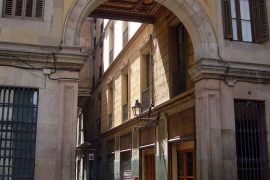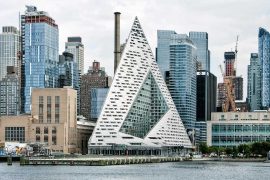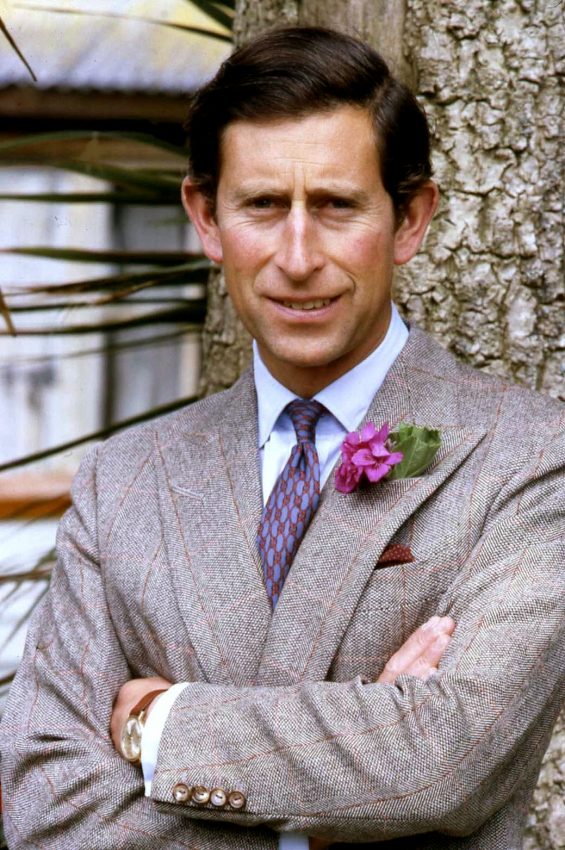
The MNAC dedicates a monographic exhibition to an exceptional painter...

Barcelona can boast of having a few European-style passageways that...

The image of a skyscraper-free Barcelona is part of a...

Impossibly few companies dedicated to the design sector have a...

One of the most unknown aspects of one of today’s...

Ramon Espel has been Construction Manager at the Sagrada Família...

Nowadays, the Association Pau i Justícia is host to the...

Penelles, a small town in Lleida with some five-hundred inhabitants,...

Gonzalo Goytisolo thinks of himself as an art mercenary. “In...

The language of art is the language of the soul....

Música clásica sobre la arena de la playa en dos...

The first session of the cycle on the regatta organized...

The hospital's managing director, Manel del Castillo, and the pharmaceutical...

Generalitat y Ayuntamiento impulsarán dos equipamientos de 'Casa de les...

Leticia Beleta, director of Alexion Pharmaceuticals in Spain and Portugal,...

We all have a friend who never leaves the Gràcia...

Barcelona director opts for Best International Film with 'La sociedad...

The hotel and industrial sectors softened the market's decline last...

The technology company, with a workforce of 35 employees and...

“The women of yesteryear were strong and had to fight...

Windsor had been likened to a sepulchre and Buckingham to a chain store; as for St James’s Palace, George III had planned to demolish it and plant a field of turnips on its soil. Naturally, when sketching out Prince Charles’ passion for architecture, his family tree must be discarded: keener on horse breeding than on promoting the arts, the Hannover and the Windsor have well earned their reputation that any confusion with the Medici is pure coincidence. It may be —some say— an old tradition of dynastic philistinism; it may also be a response to deeply-rooted skepticism of the British towards any grand projet. Be what it may, the most prestigious Royal Crown on the planet did not even make a shy attempt to build a Versailles to perpetuate its glory, pomp and circumstance. Because of this, this intense —even eccentric— interest of Prince Charles of England for architecture has caused even greater surprise. This interest has even reached the status of a national debate.
Between those who have “a conscience of nation” and those who consider him an ill-informed dilettante, this is the only merit acknowledged by everyone: i.e. having turned into a public debate what is, quintessentially, the great public art. On the other hand, the Prince of Wales himself has always known that his opinions would be brought into disrepute. Supporter of urban planning adapted to human measure, and an architectural language adapted a location, it has certainly been tempting to prejudge his ideas as if they came from an irresponsible amateur. Indeed, the aesthetic fixation of Prince Charles would only be the hobby of a leisure-seeking heir, touched —to make things worse— by conservative dandyisms and nostalgias. “Some judge my opinions”, confesses Prince Charles himself, “as opposed to progress and the needs of the contemporary world”. His caricature is an easy target: after all, we are talking about a man who does watercolor painting, is comforted with Leopardi and has shown a consistent interest in speculative agriculture and natural medicine. Such activities are less popular than horseracing. He himself has bitterly accused “the violent and vitriolic reactions” that his furor aedificandi has caused here and there. Not without reason, if the fiercest avant-gardes would censor his aesthetic tenets, the milder fringes of society also found a reason for astonishment: with his attacks to the vedettariat of architecture, Prince Charles seemed to destabilize the sacred precepts that, since the 19th century to these days, prevents the constitutional monarchy to “get into political fights”.
However, thirty years from his early onslaughts against hypertechnologized architecture, Prince Charles of England has earned the respect of society and the consideration of seriousness. And this is quite meritable. He has freed people, learned or unlearned, to criticize the arrogance of some projects that are more photogenic than habitable. He has been supported —from Leon Krier to Quinlan Terry— by reputable experts. He has built, through speeches and books, a doctrinal body. He has even managed —e.g. community urban planning of Poundbury— to put his ideas at work in front of the Priapism of skyscrapers and concrete blocks where only urine and graffiti prosper. Likewise, the Prince of Wales has demonstrated that his urge “is not the result of trying to find something to make his day”. This is, rather, a fight for a vocational community architecture aiming to create beauty and continuity.
If painting has been improvable and poetry unrivalled, architecture remains as the most contentious of the British arts. Maybe because of this, it deserved some royal attention: equally articulate when expressing the best or the worst, the construction of the UK has brought the appearance of the “Satanic looms” of the Industrial Revolution and the serene pomp of the large cottages. Suffice it to follow a thought: the Spanish life can be read through some of its painters; however, the English architectural drama accompanies naturally its national route. We can see it in the monastic colleges of Oxbridge and the crime-loaded streets and lanes of Jack the Ripper’s London. It is equally found in the age of the optimism of its stations as in Dickensian taverns and orphanages. It appears in the solemn liturgy, pomp and circumstance of its Parliament, in the hopeless slums of Trainspotting and the “market-cities” of mildness of Shakespeare. Finally, it shines both in Indian pavilions speaking volumes about the Empire and the new homes for multimillionaires with breathtaking views over the river Thames. At this point, we can also remember that the greatest British aesthetes would make their presence and influence felt on architecture, urban planning and landscaping, from Arcadian suggestions by Capability Brown to William Morris’s trading dreaminess, archaic illusions alla Beckford or the look on the past, so reverent, by John Ruskin.
If England can be clearly read through its buildings, is this because —with the exception of Holland— no other civilization has been so closely linked to domesticity? These traits are not devoid of political implications: homes represent the twin ideas of freedom and property, of this intimacy summed up in the phrase “my house, my castle”. Even its classical style is embedded in an idea of republican virtue. Using a more mundane language, one does not have to read through Jane Austen’s complete catalogue to infer that its homes were scenarios for artistic beauty, for its model of man, for its sports and social rituals —tea-time, hunting, garden parties— of the English gentry. But if these life houses, or country houses, fixed “the matrix of British culture”, no less attention deserves successful stories of urban planning.
It is commonplace to state, with Lord Kennett, that English cities are “a fiasco”. And yet, one cannot deny that England was the first among the largest countries in the world to define modern urbs. In the early 19th century, there were no less than 100,000 inhabitants only in London; in less than one hundred years, there were twenty-three cities above this figure. For the sake of city planning, the British would coin an invention that equalized usefulness, beauty and service to high population density: Georgian and Victorian terraced houses which, according to Harry Mount, are the main contribution of the English constructive repertoire and that, according to Nikolaus Pevsner, have simply become one of the biggest success stories of 18th century Europe. Their predicament still holds true: the most sought-after houses in today’s London, on Campden Hill Square are a placid ensemble of Georgian harmonious terraced houses. This architecture stands for order and welfare. However, we’re talking about Great Britain, may nobody get carried away by lyricism: practical, the rows of Georgian and Victorian houses could be extended ad infinitum, and their decorations confirmed endless variations around the same theme.
In John Soane’s and Robert Adam’s country, there stands an intelligible tradition worth worshipping and imitating. This veneration is as vernacular as it is open, enriched by the contribution of visionaries and utopians —e.g. Titus Salt, Ebenezer Howard, the Garden City— in search of consolidating social reforms by upgrading urban spaces. In the end, the result gravitates on the past and makes Scruton’s statement congruous: from the 19th century onwards, the conservationist endeavour has been “the most fertile intellectual effort of the British”.
Great Britain has not always been up to the challenge, or rather it has not always been able to avoid disaster. On this issue, the English architectural legacy would suffer more due to man-made activities than to the passage of time. Montgomery-Massingberd estimate that, between 1875 and 1975, nearly one thousand country houses in Great Britain collapsed. As regards cities, the post-war reconstruction labours —Sheffield, Coventry, and London itself— have deserved being described as “a vandalic orgy”. On criticizing housing policies by British PM —and former minister of housing issues— Harold Macmillan, Alan Clark cites verbatim the following commentary: “Only agonizing countries try to maintain symbols from the past”. With these premises, his corollary was clear: the progressive substitution of architectural heritage for buildings “so sinister whose only atonement was its rapid capacity to degrade themselves”. The year was 1987, and Prince Charles took a step forward and dared denouncing it. “You have to give this much to the Luftwaffe. When it knocked down our buildings —he said—, at least they were not replaced with anything worse than debris”.
Anyone who enjoys pearls of rhetoric wisdom would do well with preparing himself a glass of good wine and listen to Prince Charles’s speeches on architecture. Rarely has a royal taken so many liberties; rarely did he make so many meaningful statements, believe it or not. It would appear that the prince has borrowed his best darting comments from Tom Wolfe and his mockery —From Bauhaus to Our House— of modern architecture. Thus, Birmingham Central Library —kind of mazacotic brutalism— said that it looked like “a place where books are incinerated, not kept”. As regards the extension of the British Library, he quite rightly and painfully compared it to a police academy.
As regards plans to build around Saint Paul’s Cathedral, he was obviously merciless in his stance: he said they were “a jostling scrum of office buildings so mediocre that the way you ever remember them is by the frustration they induce”. Since, around 1984, he described the proposed extension to the National Gallery in London as a “monstrous carbuncle on the face of a much-loved elegant friend”, each year some volunteers give the Carbuncle Award to the ugliest building in the British Isles.
Perhaps the importance of these princely words was not humour, but humour —undoubtedly— aimed to undermine megalomania of so many architectural Narcissus who conceived houses as “living machines” rather than as spaces for human dignity. Of course, when the Prince censored “the integral ugliness and mediocrity of the buildings (…) and the residential ensembles, not to mention the horror and desolation of so many urban expansions”, the architects rushed to retaliate. Charles of England —they said— should put things right and shoot instead the promoters, legislators and municipalities.
However, Prince Charles was able to argue his position –and so he has done so now and again, forcefully—. In his view, it is a certain teaching establishment which, “in the fifties and seventies”, imposes his “cultural agenda”. In theory, this was about launching a “new architecture”, suitable for all post-war needs, and capable to reflect “the spirit of the time” —a time of technology and progress— through “novel ideas” and “revolutionary construction materials”. In practice, this generated a group of mandarins who, almost unrestrictedly, allowed themselves, with a certain despotic abuse of reason, enthrone their ideas with the least sensitiveness towards an obvious element: what people want their house or area to be. The final result? The Prince reckons it is not too promising: “Senseless destruction in the name of progress (…) and the proliferation of Frankensteinian monsters, devoid of character, alienated and ill-loved by everyone, except for the professors who have designed them in their laboratories”.
A final coda remains —in the Prince’s view— the lamentation. The grief for an architectural piece that denies the past —“when a man loses his past, he loses his soul”— and its surroundings. The lament for the arrogance of having abstracted from climate change alerts, local materials, the life-long principles, from everything that gave “sense of belonging and order” to architecture. The pain for so much beauty destroyed. The uncomfortability of living, not according to how one wants to live, but according to how some individuals want you to live, from their blueprints, they decide how one has to live. Curiously enough, post-war British architecture —with almost no exception— would only be able to deteriorate, not to get old.
Wittier or more serious, should Prince Charles have stuck to talking about architectural criticism, he could have earned an accusation of being inconsequential. Through his foundations and books, he has never stopped explaining his stance and fostered good practices. However, the Poundbury Project asserted his authority: this consisted in, since the early nineties, building a new urban extension in Dorchester, with the extra responsibility of respecting the individual character of a county featured in Thomas Hardy’s works. They said this Project was doomed to failure. Yet this was the long-awaited alibi to implement in vivo the Prince’s ideas: human-size scales, hardly no signaling noise, controlled heights, community areas, co-habitating mingle of houses and shops, green measures and an eclectic style combined with classicism.
The results are now real. Nowadays, the Poundbury erected by Leon Krier is —like Seaside in Florida— the paragon of “new urban planning” and, above all, a model of residential success: suffice it to say that it already has over one thousand houses, and in a few years the figure will double. All indicates that this is a place of life quality, and beauty. On celebrating with a stroll the first twenty years of the town, the Prince blurted out the following insight: “After all, it was worth being so obstinate”.

Windsor had been likened to a sepulchre and Buckingham to a chain store; as for St James’s Palace, George III had planned to demolish it and plant a field of turnips on its soil. Naturally, when sketching out Prince Charles’ passion for architecture, his family tree must be discarded: keener on horse breeding than on promoting the arts, the Hannover and the Windsor have well earned their reputation that any confusion with the Medici is pure coincidence. It may be —some say— an old tradition of dynastic philistinism; it may also be a response to deeply-rooted skepticism of the British towards any grand projet. Be what it may, the most prestigious Royal Crown on the planet did not even make a shy attempt to build a Versailles to perpetuate its glory, pomp and circumstance. Because of this, this intense —even eccentric— interest of Prince Charles of England for architecture has caused even greater surprise. This interest has even reached the status of a national debate.
Between those who have “a conscience of nation” and those who consider him an ill-informed dilettante, this is the only merit acknowledged by everyone: i.e. having turned into a public debate what is, quintessentially, the great public art. On the other hand, the Prince of Wales himself has always known that his opinions would be brought into disrepute. Supporter of urban planning adapted to human measure, and an architectural language adapted a location, it has certainly been tempting to prejudge his ideas as if they came from an irresponsible amateur. Indeed, the aesthetic fixation of Prince Charles would only be the hobby of a leisure-seeking heir, touched —to make things worse— by conservative dandyisms and nostalgias. “Some judge my opinions”, confesses Prince Charles himself, “as opposed to progress and the needs of the contemporary world”. His caricature is an easy target: after all, we are talking about a man who does watercolor painting, is comforted with Leopardi and has shown a consistent interest in speculative agriculture and natural medicine. Such activities are less popular than horseracing. He himself has bitterly accused “the violent and vitriolic reactions” that his furor aedificandi has caused here and there. Not without reason, if the fiercest avant-gardes would censor his aesthetic tenets, the milder fringes of society also found a reason for astonishment: with his attacks to the vedettariat of architecture, Prince Charles seemed to destabilize the sacred precepts that, since the 19th century to these days, prevents the constitutional monarchy to “get into political fights”.
However, thirty years from his early onslaughts against hypertechnologized architecture, Prince Charles of England has earned the respect of society and the consideration of seriousness. And this is quite meritable. He has freed people, learned or unlearned, to criticize the arrogance of some projects that are more photogenic than habitable. He has been supported —from Leon Krier to Quinlan Terry— by reputable experts. He has built, through speeches and books, a doctrinal body. He has even managed —e.g. community urban planning of Poundbury— to put his ideas at work in front of the Priapism of skyscrapers and concrete blocks where only urine and graffiti prosper. Likewise, the Prince of Wales has demonstrated that his urge “is not the result of trying to find something to make his day”. This is, rather, a fight for a vocational community architecture aiming to create beauty and continuity.
If painting has been improvable and poetry unrivalled, architecture remains as the most contentious of the British arts. Maybe because of this, it deserved some royal attention: equally articulate when expressing the best or the worst, the construction of the UK has brought the appearance of the “Satanic looms” of the Industrial Revolution and the serene pomp of the large cottages. Suffice it to follow a thought: the Spanish life can be read through some of its painters; however, the English architectural drama accompanies naturally its national route. We can see it in the monastic colleges of Oxbridge and the crime-loaded streets and lanes of Jack the Ripper’s London. It is equally found in the age of the optimism of its stations as in Dickensian taverns and orphanages. It appears in the solemn liturgy, pomp and circumstance of its Parliament, in the hopeless slums of Trainspotting and the “market-cities” of mildness of Shakespeare. Finally, it shines both in Indian pavilions speaking volumes about the Empire and the new homes for multimillionaires with breathtaking views over the river Thames. At this point, we can also remember that the greatest British aesthetes would make their presence and influence felt on architecture, urban planning and landscaping, from Arcadian suggestions by Capability Brown to William Morris’s trading dreaminess, archaic illusions alla Beckford or the look on the past, so reverent, by John Ruskin.
If England can be clearly read through its buildings, is this because —with the exception of Holland— no other civilization has been so closely linked to domesticity? These traits are not devoid of political implications: homes represent the twin ideas of freedom and property, of this intimacy summed up in the phrase “my house, my castle”. Even its classical style is embedded in an idea of republican virtue. Using a more mundane language, one does not have to read through Jane Austen’s complete catalogue to infer that its homes were scenarios for artistic beauty, for its model of man, for its sports and social rituals —tea-time, hunting, garden parties— of the English gentry. But if these life houses, or country houses, fixed “the matrix of British culture”, no less attention deserves successful stories of urban planning.
It is commonplace to state, with Lord Kennett, that English cities are “a fiasco”. And yet, one cannot deny that England was the first among the largest countries in the world to define modern urbs. In the early 19th century, there were no less than 100,000 inhabitants only in London; in less than one hundred years, there were twenty-three cities above this figure. For the sake of city planning, the British would coin an invention that equalized usefulness, beauty and service to high population density: Georgian and Victorian terraced houses which, according to Harry Mount, are the main contribution of the English constructive repertoire and that, according to Nikolaus Pevsner, have simply become one of the biggest success stories of 18th century Europe. Their predicament still holds true: the most sought-after houses in today’s London, on Campden Hill Square are a placid ensemble of Georgian harmonious terraced houses. This architecture stands for order and welfare. However, we’re talking about Great Britain, may nobody get carried away by lyricism: practical, the rows of Georgian and Victorian houses could be extended ad infinitum, and their decorations confirmed endless variations around the same theme.
In John Soane’s and Robert Adam’s country, there stands an intelligible tradition worth worshipping and imitating. This veneration is as vernacular as it is open, enriched by the contribution of visionaries and utopians —e.g. Titus Salt, Ebenezer Howard, the Garden City— in search of consolidating social reforms by upgrading urban spaces. In the end, the result gravitates on the past and makes Scruton’s statement congruous: from the 19th century onwards, the conservationist endeavour has been “the most fertile intellectual effort of the British”.
Great Britain has not always been up to the challenge, or rather it has not always been able to avoid disaster. On this issue, the English architectural legacy would suffer more due to man-made activities than to the passage of time. Montgomery-Massingberd estimate that, between 1875 and 1975, nearly one thousand country houses in Great Britain collapsed. As regards cities, the post-war reconstruction labours —Sheffield, Coventry, and London itself— have deserved being described as “a vandalic orgy”. On criticizing housing policies by British PM —and former minister of housing issues— Harold Macmillan, Alan Clark cites verbatim the following commentary: “Only agonizing countries try to maintain symbols from the past”. With these premises, his corollary was clear: the progressive substitution of architectural heritage for buildings “so sinister whose only atonement was its rapid capacity to degrade themselves”. The year was 1987, and Prince Charles took a step forward and dared denouncing it. “You have to give this much to the Luftwaffe. When it knocked down our buildings —he said—, at least they were not replaced with anything worse than debris”.
Anyone who enjoys pearls of rhetoric wisdom would do well with preparing himself a glass of good wine and listen to Prince Charles’s speeches on architecture. Rarely has a royal taken so many liberties; rarely did he make so many meaningful statements, believe it or not. It would appear that the prince has borrowed his best darting comments from Tom Wolfe and his mockery —From Bauhaus to Our House— of modern architecture. Thus, Birmingham Central Library —kind of mazacotic brutalism— said that it looked like “a place where books are incinerated, not kept”. As regards the extension of the British Library, he quite rightly and painfully compared it to a police academy.
As regards plans to build around Saint Paul’s Cathedral, he was obviously merciless in his stance: he said they were “a jostling scrum of office buildings so mediocre that the way you ever remember them is by the frustration they induce”. Since, around 1984, he described the proposed extension to the National Gallery in London as a “monstrous carbuncle on the face of a much-loved elegant friend”, each year some volunteers give the Carbuncle Award to the ugliest building in the British Isles.
Perhaps the importance of these princely words was not humour, but humour —undoubtedly— aimed to undermine megalomania of so many architectural Narcissus who conceived houses as “living machines” rather than as spaces for human dignity. Of course, when the Prince censored “the integral ugliness and mediocrity of the buildings (…) and the residential ensembles, not to mention the horror and desolation of so many urban expansions”, the architects rushed to retaliate. Charles of England —they said— should put things right and shoot instead the promoters, legislators and municipalities.
However, Prince Charles was able to argue his position –and so he has done so now and again, forcefully—. In his view, it is a certain teaching establishment which, “in the fifties and seventies”, imposes his “cultural agenda”. In theory, this was about launching a “new architecture”, suitable for all post-war needs, and capable to reflect “the spirit of the time” —a time of technology and progress— through “novel ideas” and “revolutionary construction materials”. In practice, this generated a group of mandarins who, almost unrestrictedly, allowed themselves, with a certain despotic abuse of reason, enthrone their ideas with the least sensitiveness towards an obvious element: what people want their house or area to be. The final result? The Prince reckons it is not too promising: “Senseless destruction in the name of progress (…) and the proliferation of Frankensteinian monsters, devoid of character, alienated and ill-loved by everyone, except for the professors who have designed them in their laboratories”.
A final coda remains —in the Prince’s view— the lamentation. The grief for an architectural piece that denies the past —“when a man loses his past, he loses his soul”— and its surroundings. The lament for the arrogance of having abstracted from climate change alerts, local materials, the life-long principles, from everything that gave “sense of belonging and order” to architecture. The pain for so much beauty destroyed. The uncomfortability of living, not according to how one wants to live, but according to how some individuals want you to live, from their blueprints, they decide how one has to live. Curiously enough, post-war British architecture —with almost no exception— would only be able to deteriorate, not to get old.
Wittier or more serious, should Prince Charles have stuck to talking about architectural criticism, he could have earned an accusation of being inconsequential. Through his foundations and books, he has never stopped explaining his stance and fostered good practices. However, the Poundbury Project asserted his authority: this consisted in, since the early nineties, building a new urban extension in Dorchester, with the extra responsibility of respecting the individual character of a county featured in Thomas Hardy’s works. They said this Project was doomed to failure. Yet this was the long-awaited alibi to implement in vivo the Prince’s ideas: human-size scales, hardly no signaling noise, controlled heights, community areas, co-habitating mingle of houses and shops, green measures and an eclectic style combined with classicism.
The results are now real. Nowadays, the Poundbury erected by Leon Krier is —like Seaside in Florida— the paragon of “new urban planning” and, above all, a model of residential success: suffice it to say that it already has over one thousand houses, and in a few years the figure will double. All indicates that this is a place of life quality, and beauty. On celebrating with a stroll the first twenty years of the town, the Prince blurted out the following insight: “After all, it was worth being so obstinate”.
